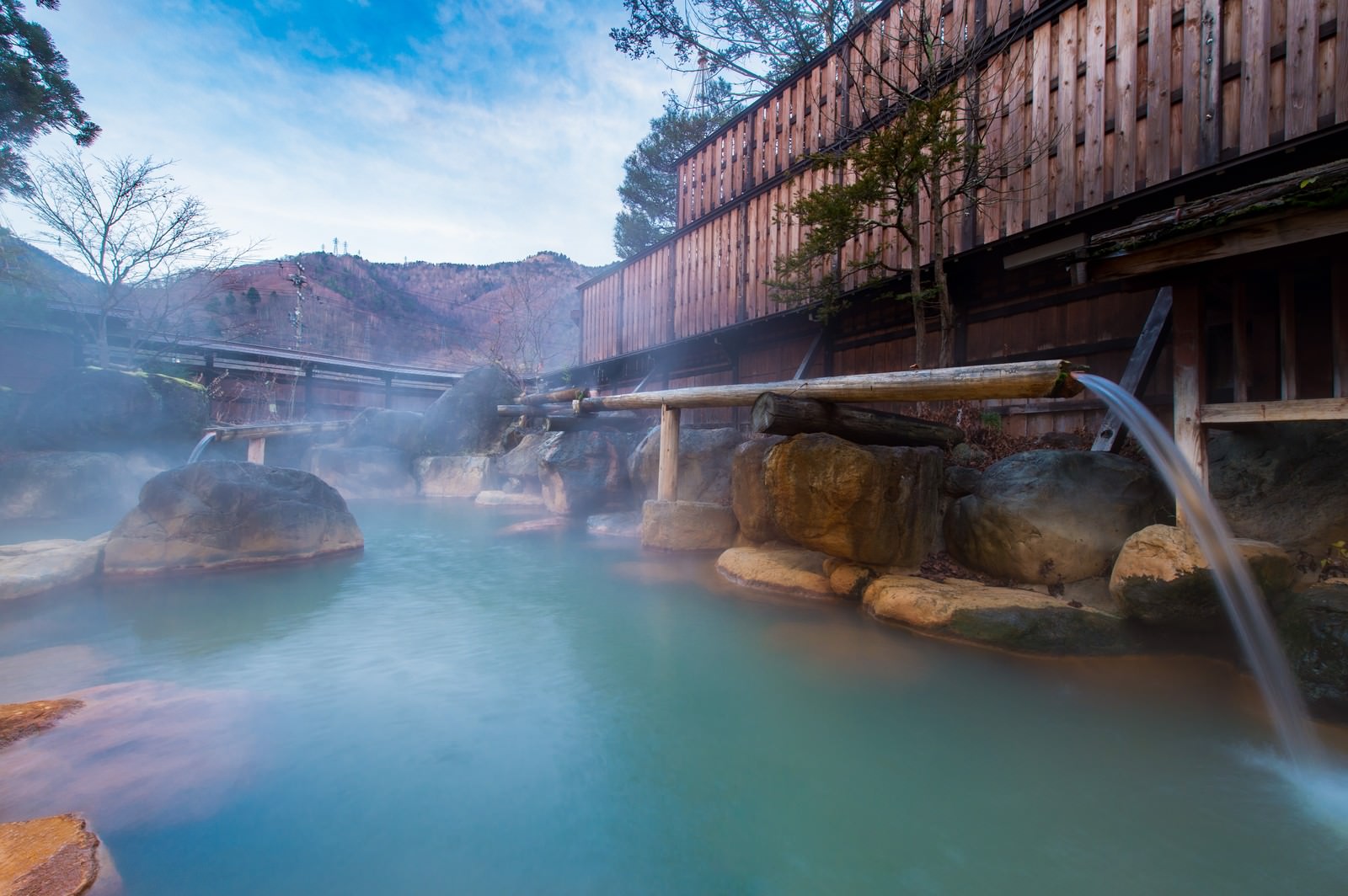Please Note: This tour is part of a complete guided tour of Japan which can be found here: The Best of Japan in 7 Days. However, this tour can be used on it’s own as a single day trip or incorporated in to your own tour itinerary. This tour was also designed to be experienced during Japan’s Cherry Blossom season however you can experience it at any time of the year- minus the blossom trees!
Medieval to Modern Osaka Tour [Guided Tour]
This tour involves the following (tick them off as you go!):
- Awe at the exquisite beauty of cherry blossoms
- Enjoy an incredible panoramic 360° view of Osaka city skyline
- Transport yourself back to Medieval times with a visit to Osaka Castle
- Get sand between your toes at the city beach
- Partake in the Japanese tradition of hanami
- Learn about Japan’s medieval history including the incredible Samurai
- Dress up in stylish Samurai or Kimono costumes
- Experience the efficiency of the Japan railway
- Watch a local game of baseball
- Test your luck at the games arcades
- Observe the natural wildlife such as herons, sparrows and turtles
- Ponder the mystery surrounding the construction of impossibly enormous stones
- Walk through the fantastically vibrant signage and neon lights of Dōtonbori Street
- Perform the purification ritual misogi and pray at a temple
- Taste delicious and authentic Japanese food such as okonomiyaki, takoyaki or ramen
Due to the fact that you could begin the day anywhere in Osaka or even Kyoto, I will begin the tour from Shin-Osaka Station in Osaka as this is most likely the starting location for the majority of readers.
The goal is to reach Sakuranomiya Station in Osaka so if you are actually situated closer to this station, skip the below directions and start reading from the Sakuranomiya Station header.
Personally, I’m an early bird when it comes to adventure. I like to be up and out exploring as soon as possible to make the most of every second. As a result, I would aim to be at Shin-Osaka Station around 9.30am. However I understand this is not always achievable, you can start the tour later if it suits you. Check out the bottom of the article for adjusting the itinerary to your needs.
9:30am: Shin-Osaka Station (新大阪駅 Shin-Ōsaka-eki)
Take the Tokaido-Sanyo Line Train to Osaka Station (Towards Osaka, Aboshi, Himeji, Koshienguchi, Nishi-Akashi, Shin-Sanda or Banshu-Ako). Get off at the next stop.
Top Tip! Rather than stressing about trying to understand the layout of the Station or which platform to head to; ask the employee at the ticket gate. Not everyone in Japan is fluent in English so make sure to show them the name of the Station you are looking for. They will be able to direct you to the correct Platform. This is a real time saver and prevents getting lost.
Top Tip! Is the weather going to be clear? Osaka Castle grounds are a perfect location for experiencing hanami (a wonderful Japanese tradition of enjoying a picnic beneath the beautiful sakura trees). Even if you are not completing this tour during cherry blossom season, the castle grounds are still a fantastic place to stop for lunch and absorb the local atmosphere. As a result, I recommend buying lunch from a convenience store at Shin-Osaka Station. In addition, this will also save time and money as opposed to stopping at a restaurant; bonus!
10am: Osaka Station (大阪駅 Ōsaka-eki)
Take the Osaka Loop Line Train to Sakuranomiya Station (Heading East/Clockwise towards Kyobashi or Tennoji). Get off at the second stop.
Top Tip! If you didn’t buy any lunch at Shin-Osaka Station, then I recommend picking some up at Osaka Station.
10:30am: Sakuranomiya Station (桜ノ宮駅 Sakuranomiya-eki)
This station only has two exits (South Side (Exit 1) and North Side (Exit 2)) so don’t worry too much about which exit you end up at. We want to aim to exit via the South Exit/Exit 1; this is the exit with a decorative round-about in front. If you end up at North Exit/Exit 2, don’t worry, simply continue down the road to your left until you reach a tunnel. Take this underpass to reach the south side of the station.
Sakuranomiya Station South Exit/Exit 1. Image Capture:  2015 Google, DigitalGlobe.
2015 Google, DigitalGlobe.
From the south exit of Sakuranomiya Station, turn right and follow the road. Keep going, passing the mini-cemetery on your left. When you reach the edge of the river (lined with bikes), turn left.

Street from Sakuranomiya Station. Image Capture: ©2016 Google, DigitalGlobe.
Keep following this road, passing a bridge on your right. Use the zebra crossings to access the pathway between Koban Police Station and the bridge. There’s a large sign about the river-side walkway which you are about to discover. Walk beneath over 4,500 cherry blossom trees along the pathway, following the river on your right. Eventually, at the end of the walk, take the stairs to your left to access the main road again.
Top Tip! Along this pathway look out for taking your shoes off at the city beach, watching a local game at the baseball field, spotting wildlife and waving at boats as they sail down the river.

The start of the Cherry Blossom Walkway in Sakuranomiya. Image Capture: ©2016 Google, DigitalGlobe.

The end of the Cherry Blossom Walkway in Sakuranomiya. Image Capture:  2016 Google, DigitalGlobe.
2016 Google, DigitalGlobe.
Take the stairs, leading down, on the opposite side of the road. Continue beneath the train tracks and on the other side, take the access ramp directly in front of the steps. This walkway, passes over the traffic and leads straight to the castle grounds.

The steps descending beneath the railway tracks. Image Capture: ©2016 Google, DigitalGlobe.

Access ramp leading over the traffic to the entrance of Osaka Castle Grounds. Image Capture: ©2016 Google, DigitalGlobe.
11:30am: Osaka Castle Grounds (大坂城 or 大阪城, Ōsaka-jō)
Once you reach the end of the ramp walkway, turn left into the castle grounds. You’ll pass through Peach Grove; a beautiful garden of blossom trees.
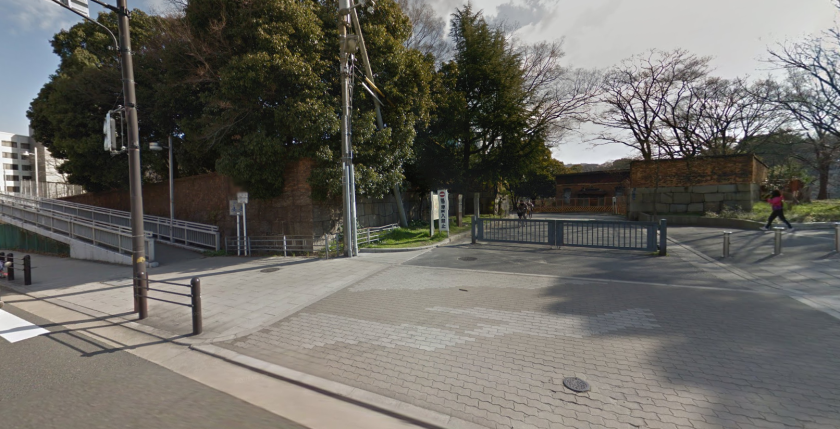
The end of the access ramp and entrance to Osaka Castle Grounds. Image Capture: ©2015 Google, DigitalGlobe.
Top Tip! If you’ve been roughly following the time guidelines of the itinerary, you’ll probably be hungry by now. Find a bench or a spot beneath the blossom trees to absorb the atmosphere and experience hanami. If you didn’t bring any lunch or the weather isn’t suitable, don’t worry, there’s a mall across the river where you can stop. In addition, in certain seasons and weather, there are many food stalls throughout the castle grounds selling cheap but delicious snacks.
After lunch, continue over the castle moat and through Aoyamon Gate which is your first right after the Peach Grove. Follow the path to the right to cross Gokurakubashi Bridge on your left. Continue ascending up to the castle.
12:30pm: Osaka Castle & Museum (大坂城 or 大阪城, Ōsaka-jō)
The entrance fee to Osaka Castle Museum is 600 Yen per person. Children aged 15 and younger gain free entry. Open 9am – 5pm (Last admission is 4.30pm). Closed December 28th – January 1st.
Osaka Castle represents the power and fortune of Hideyoshi Toyotomi. Very little is known about Hideyoshi’s early life though it is believed he was born to a peasant family of little significance. However he sought adventure and in 1558 CE joined the Oda Clan; a powerful band of daimyō (feudal lords). After numerous acts of initiative and ingenious problem solving, Hideyoshi gained status within the clan. His charming charisma was an invaluable tool in negotiating opposing lords and Samurai to submit loyalty to his clan’s leader. This resulted in Hideyoshi becoming one of the clan’s most esteemed generals by 1567 CE and was awarded the surname Hashiba. Hideyoshi continued to gain prominence and advanced to daimyō status after leading several victorious battles. The leader of the Oda clan was assassinated in 1582 CE and tensions grew over who should be the new successor. Hideyoshi secured clan leadership for the youngest son of the previous leader and increased his control over the clan. In 1583, Hideyoshi began construction of Osaka Castle at the former site of a temple. He didn’t progress to Shogun (dictator ruler) status but instead became Kampaku (Imperial Regent) to the Emperor in 1586 CE. The Imperial Court assigned Hideoyoshi a new surname and clan; Toyotomi.
Hideyoshi proceeded in his quest to unify Japan. He assured power over both the peasants and daimyō by controlling arms and religion. Later in life, he also focused his ambitions on conquering China and Korea. Despite his best efforts, Hideyoshi failed to secure power for his heir upon his death in 1598 CE. Tokugawa Ieyasu, Regent to Hideyoshi’s heir, brought the downfall of the Toyotomi clan and Osaka Castle, establishing himself as Shogun. The two clans clashed in 1615 CE at the Siege of Osaka. After a bloody, eight month battle, Ieyasu wiped out the remainder of the Toyotomi family and burned the castle down. Since then, Osaka Castle has been recontructed, altered and destroyed numerous times including becoming a military arsenal base during World War II. Luckily for tourists, the Edo-Era castle you see today was rebuilt in 1995 CE for you to enjoy and imagine yourself back in time during Hideyoshi Toyotomi’s rule.
Top Tip! Don’t forget to head to the Observation Deck at the top of the Castle for a breathtaking panoramic view of Osaka city skyline.
Top Tip! Now you’ve learnt about the fascinating Samurai, how about dressing up as one? The Museum offers the chance to try on a traditional Samurai helmet and surcoat or Kimono for 500 Yen per person. Get your photo taken in style and capture a moment in time you won’t forget.
How long you stay at Osaka Castle depends entirely on crowds, your personal viewing preference and whether you want to attend the near by Osaka Museum of History. Check out the bottom of the itinerary for information on the Museum of History and how to incorporate a visit in to your day. I estimate that the Osaka Castle Museum takes 2-3 hours but this is incredibly variable.
3:30pm: Osaka Castle Grounds (大坂城 or 大阪城, Ōsaka-jō)
Once you exit the Museum, continue south to the grounds in front of the Castle.
Top Tip! Depending on the weather and season, this is a perfect spot to stop and rest. Revitalise yourself with some local street food and enjoy the atmosphere of the hustle and bustle.
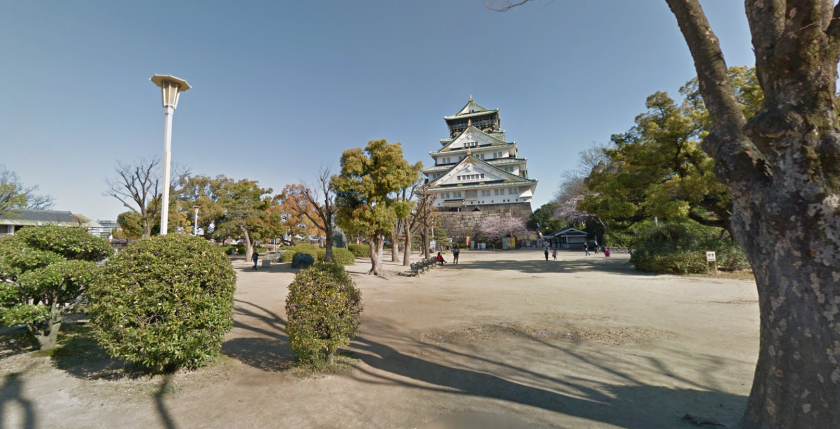
Osaka Castle Grounds. Image Capture: ©2016 Google, DigitalGlobe.
Head to the bottom corner of the grounds past the former Osaka City Museum on your left. As you follow the bending path, take a moment to admire the wall of colossal sized stones including the largest one commonly known as the ‘Octopus Stone’ due to it’s distinctive markings. These impressive stones weigh between 50-108 tonnes (50,000-108,000Kg) which far surpasses that of the Stonehenge and the Great Pyramid. Imagine trying to carry a weight equal to 12 elephants! Even more unfathomable is how these gigantic rocks were transported and erected here.
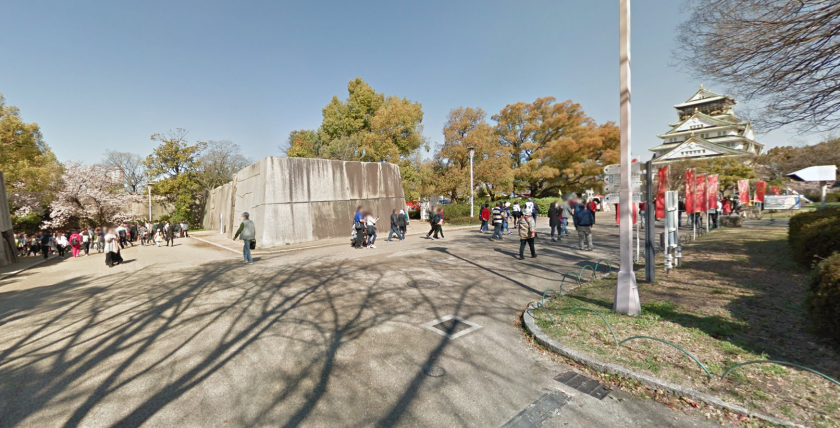
Osaka Castle Grounds. Image Capture: ©2016 Google, DigitalGlobe.
Exiting the area through Sakuramon Gate; there are a few points of interest directly in front including a statue of Hideyoshi Toyotomi. Continue along the path to the right (facing away from the gate) and follow it as it bends right and left. The entrance to Nishinomaru Garden on your right and is located where the former residence of Toyotomi Hideyoshi’s wife once stood.
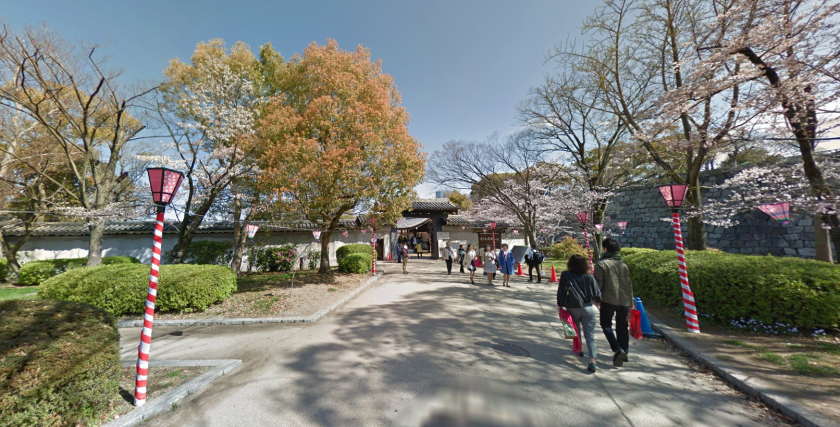
Entrance to Nishinomaru Garden. Image Capture: ©2016 Google, DigitalGlobe.
Top Tip! If you have the time, you may want to enter the garden. It features a beautiful lawn, views of the castle and around 600 cherry trees. It also has the added bonus of being quieter than the rest of the castle grounds. The entrance fee to the garden is 200 Yen per person (350 Yen per person during the evening during the Cherry Blossom season). Children aged 15 and younger and Osaka residents aged 65 and over gain free entry. Open 9am – 5pm (Mar-Oct), 9am – 4.30pm (Nov-Feb) and 9am-8pm (Cherry Blossom Season). Last admission is 30 minutes before closing. Closed Mondays and New Years.
Just after Nishinomaru Garden you’ll pass through a large gateway with more giant wall stones. Moving on through Otemon Gate and over the moat, turn left and follow the path to the bottom corner of the castle grounds. Take the zebra crossing on your right. Continuing in straight line from the zebra crossing (with the Osaka Museum of History on your left), proceed down the pavement to the next junction. Take the stairs leading underground to Tanimachi Yonchome Station.

Zebra crossing connecting Osaka Castle Grounds and the Osaka Museum of History. Image Capture: ©2016 Google, DigitalGlobe.

Steps leading down to Tanimachi Yonchome Station. Image Capture: ©2016 Google, DigitalGlobe.
4.30pm: Tanimachi Yonchome Station (谷町四丁目駅, -eki)
There are two options here. Either;
Take the Chuo Line Train to Sakaisuji Hommachi Station (堺筋本町駅 Sakaisuji-Hommachi-eki) (Towards Cosmo Square) and get off at the next stop. Then from Sakaisuji Hommachi Station take the Sakaisuji Line Train to Nippombashi Station (Towards Tengachaya) and get off in 2 stops.
Or take the Tanimachi Line to Tanimachikyuchome Station (谷町九丁目駅 Tanimachi Kyūchōme-eki) (Towards Yaominami or Fuminosato) and get off in 2 stops. Then from Tanimachikyuchome Station take the Sen-Nichimae Line to Nippombashi Station (Towards Nodahanshin) and get off at the next stop.
Top Tip! As noted earlier: rather than stressing about trying to understand which train and platform to take, ask the employee at the ticket gate. Remember, not everyone in Japan is fluent in English so make sure to show them the name of the Station you are looking for. They will be able to direct you in the correct direction. This is a real time saver and prevents getting lost.
5pm: Nippombashi Station (日本橋駅 Nipponbashi Eki)
Leave Nippombashi Station via the Exit 2 stairs to street level. Orientate yourself so that the elevated road is behind you, the road is on your right and you are facing the same direction as the flow of traffic. Continue along this road until you come to a zebra crossing. To your left will be the entrance to Dotonbori Street.

Exit 2 of Nippombashi Station shown on the left. Head in the direction of the traffic with the elevated road behind you. Image Capture: ©2016 Google, DigitalGlobe.

Entrance to Dōtonbori Street. Image Capture: ©2016 Google, DigitalGlobe.
5.15pm: Dōtonbori Street (道頓堀 Dōtombori)
Time to feast our eyes and stomachs on one of the most famous food streets in Japan. Continue down the street, enjoying the spectacular sights and smells.
Top Tip! Dōtonbori Street is famous for it’s massive, iconic signage. Look out for a drumming clown, pufferfish, crabs, dragons, cows and octopus.
The history of Dōtonbori began during the rule of Tokugawa Ieyasu described previously at Osaka Castle. A local entrepreneur, named Yasui Dōton, was mid construction of the canal when he participated in the aforementioned Siege of Osaka. Unfortunately for Dōton, he fought for the remaining Toyotomi family and perished with them. Thankfully, the canal was completed by his cousins in 1615 CE. Since medieval times to the present day, the surrounding area became a hot spot for entertainment and leisure. Before World War II, Dōtonbori Street was famous for numerous traditional Japanese theatres. However after the devastating bombing of the war and a declining interest in traditional entertainment, the street focused it’s popularity on restaurants.
Walk down the street until you reach a Dragon on your left and Crab on your right. Turn left here where the restaurants/shops continue under a glass roof.

Turn left in to the shopping arcade once you reach the dragon and the crab. Image Capture: ©2015 Google, DigitalGlobe.
Top Tip! Look out for numerous games arcades along these streets. Venture inside and experience a fundamental aspect of modern Japanese culture. These caves of noise and flashing bright lights are still a popular pastime with copious games appealing to wide range of audiences. Most games cost 100-200 Yen per play so why not test your luck?
Take the third right down Hozenji Yokocho; a historic, stone-paved lane which has maintained the atmosphere of Osaka from hundreds of years ago (these are small alleyways so keep your eyes peeled). Once you reach the end of the alleyway, you will reach Hozenji Temple.
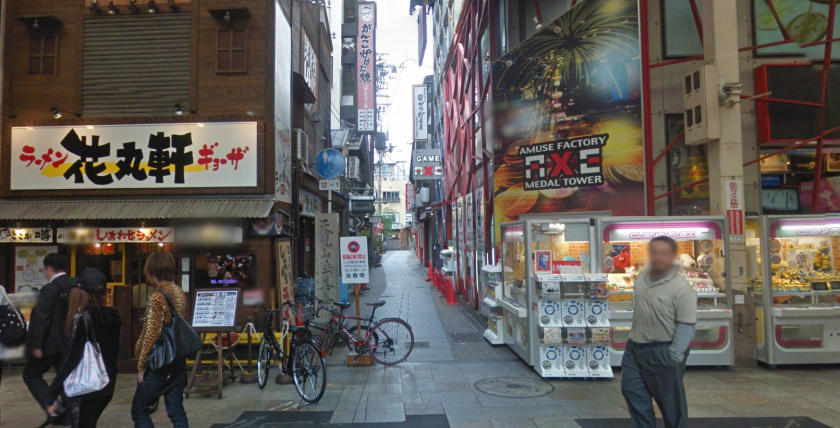
Take the third right down Hozenji Yokocho to reach Hozenji Temple. Image Capture: ©2015 Google, DigitalGlobe.
5.30pm: Hozenji Temple (法善寺, Hōzen-ji Temple)
Hozenji is a small but busy temple in Osaka that’s known for its moss covered deity Fudomyo, also known as Mizukake Fudo. Fudomyoo is the kami (divine being) of fury. He is a popular kami who is thought to protect people from evil. It’s also generally believed that he grants wishes. The statue of Fudomyoo sits in front of a fountain. It’s customary to say a prayer and pour water on the kami as an act of purification which has resulted in the statue becoming completely overgrown in moss.

Hozenji Temple. Image Capture: ©2014 Google, DigitalGlobe.
Top Tip! To pray to Fudomyoo, start by performing the purification ritual of known as misogi at the temizuya. This is a small water trough parallel to the statue on the other side of the pavement. Use the ladle provided in your right hand to scoop up water and cleanse your left hand. Next, hold the ladle in your left hand to clean your right hand. Pour some water from the ladle to your hand and use it to wash the outside of your mouth. Finally, use the remainder of the water to wash the ladle handle and place it back for someone else to use. Now you are cleansed both mentally and physically. Misogi is optional at this temple however it makes the experience more immersive and meditative. Make a coin offering (known as a saisen) in to the saisenbako (wooden box in front of the statue). Some people also clap once or twice as a appreciative greeting to a deity which is custom to do at most shrines across Japan. Bow respectfully before the statue and use the ladle present to bless Fudomyoo and his two smaller statues with water. Place your hands together to silently pray and express gratitude towards the kami. Bow once more before you leave the alter.
Continue down the pavement for a short distance in the direction the Kami is facing. Turn right at the wooden archway and walk to the end of the street where you will rejoin Dōtonbori Street.

Turn right at the wooden archway and walk to the end of the street to rejoin Dōtonbori Street. Image Capture: ©2016 Google, DigitalGlobe.
5.45pm: Dōtonbori Street (道頓堀 Dōtombori)
Turn left or right and explore the street for somewhere to stop for supper.
Top Tip! Be aware that it can get extremely busy often resulting in long queues during peak seasons. I recommend eating early or reserving a table in advance to avoid the worst of the queues.
There are endless, fantastic restaurants in Dōtonbori. Even if you were staying in Osaka for a month, you still wouldn’t be able to try it all. So how do you chose where to eat? Check out my guide on the Best Places to Eat in Dōtonbori to help you decide.
Top Tip! The atmosphere changes from day to night creating a futuristic vibe with glowing neon lights once it becomes dark. I recommend staying out late enough to see the transformation.
When you are finished exploring, dining and savouring the delights of Dōtonbori, the itinerary comes to an end. Feel free to stay out as late as you like however be aware that the trains stop running around midnight. I will continue to direct you back to Shin-Osaka Station from the start of the itinerary however this may not be relevant for you so please consider your own transport requirements.
Where ever you ended up on Dōtonbori Street, you want to orientate yourself so that you are facing west which is away from the direction we originally entered the street. A guide for locating the correct direction is that the canal should be on your right and Hozenji Temple and the undercover shopping streets should be on your left. Continue to the end of Dōtonbori street until you reach a main road. Here, turn left and walk down the road until you reach stairs leading underground to Namba Station.
Top Tip! Don’t forget to head to Ebisubashi Bridge. The bridge is an integral aspect of Dōtonbori and was originally built at the same time as the canal in 1615 CE. The current edition of the bridge was constructed in 2007 CE and is a perfect spot to capture a rainbow of fluorescent colours reflecting in the ripples of the water. You can also spot other landmarks such as the Glico Running Man signboard; an advertisement for Glico Candy which has been a popular symbol and tourist attraction for over 80 years. Ebisubashi bridge is the last right before you reach the main road leaving Dōtonbori Street.

The main road at the end of Dōtonbori Street. Image Capture: ©2015 Google, DigitalGlobe.

Steps leading down to Namba Station. Image Capture: ©2016 Google, DigitalGlobe.
Late Evening: Namba Station (難波駅, なんば駅 Nanba-eki)
Take the Midosuji Line Train to Shin-Osaka Station (Towards Shin-Osaka or Senrichuo). Get off at the seventh stop.
This is where the itinerary ends. I hope you enjoyed the tour. Please let me know if you used this guide, I appreciate all feedback. Is there anything you would add or miss from the tour? Remember, this itinerary can be used in isolation but was designed as part of a complete guided tour of Japan which can be found here: The Best of Japan in 7 Days.
Estimated Cost for the Day
The cost of the day is entirely up to you. If you have a tight budget, it is completely possible to keep expenses to a minimum by purchasing just your food and transport. You can enjoy Osaka Castle without entering the museum and the rest of the itinerary is either free or optional. As a result it is feasible to allocate around 2000-3000 Yen per person to the days expenditure (1000-1500 Yen for lunch and 1000-1500 Yen for supper). This isn’t including the cost of transport as this is so variable, due to several factors, I can not provide an estimate.
If you follow the above itinerary and permit yourself slightly more expense during meal times, the total estimated cost for the day is around 4100-5600 Yen per person. The break down is 1500-2000 Yen for lunch, 600 Yen Osaka Castle Museum entrance fee and 2000-3000 Yen for supper.
Additional costs you may want to consider is 200 Yen per person for entrance to Nishinomaru Garden and 500 Yen per person to dress up in Samurai or Kimono costumes at Osaka Castle Museum. Lastly, you may want to factor in some spending money in case you want to purchase any mementos or play games in the arcades.
Useful Information
Tweaking the Itinerary
The times listed above are purely advisory. I personally managed to complete the itinerary within the time guidelines however this is subject to outside influences such as traffic, weather, closures, etc. The timings of the day can be changed to suit your needs.
You can start the tour as early as 6am if you want to be at the Osaka Castle Museum for when the doors open at 9am. On the other hand, if the idea of waking up early sends a chill down your spine, I’d recommend starting the tour around 11am but be aware you may not fit the entire itinerary in to your visit.
If you find yourself with extra time or don’t want to spend long at Osaka Castle, you can visit the Osaka Museum of History which is situated across the road from the Castle. If you manage your timings, it is possible to visit both the Castle Museum and the Museum of History in one day. I recommend entering the Museum of History by 3.30pm to allow enough time to explore the exhibits. The entrance fee to Osaka Museum of History is 600 Yen per person. Children aged 15 and younger gain free entry. Open 9.30am – 5pm (Last admission is 4.30pm). Closed Tuesdays and December 28th – January 4th.
Other things/places to check out:
This tour has been written and tested by myself however please note that everything is subject to change. Please always check transport, opening times, maintenance closures, etc in advance.
Although I have published this tour for anyone to use, please respectfully cite this blog if it is posted elsewhere.


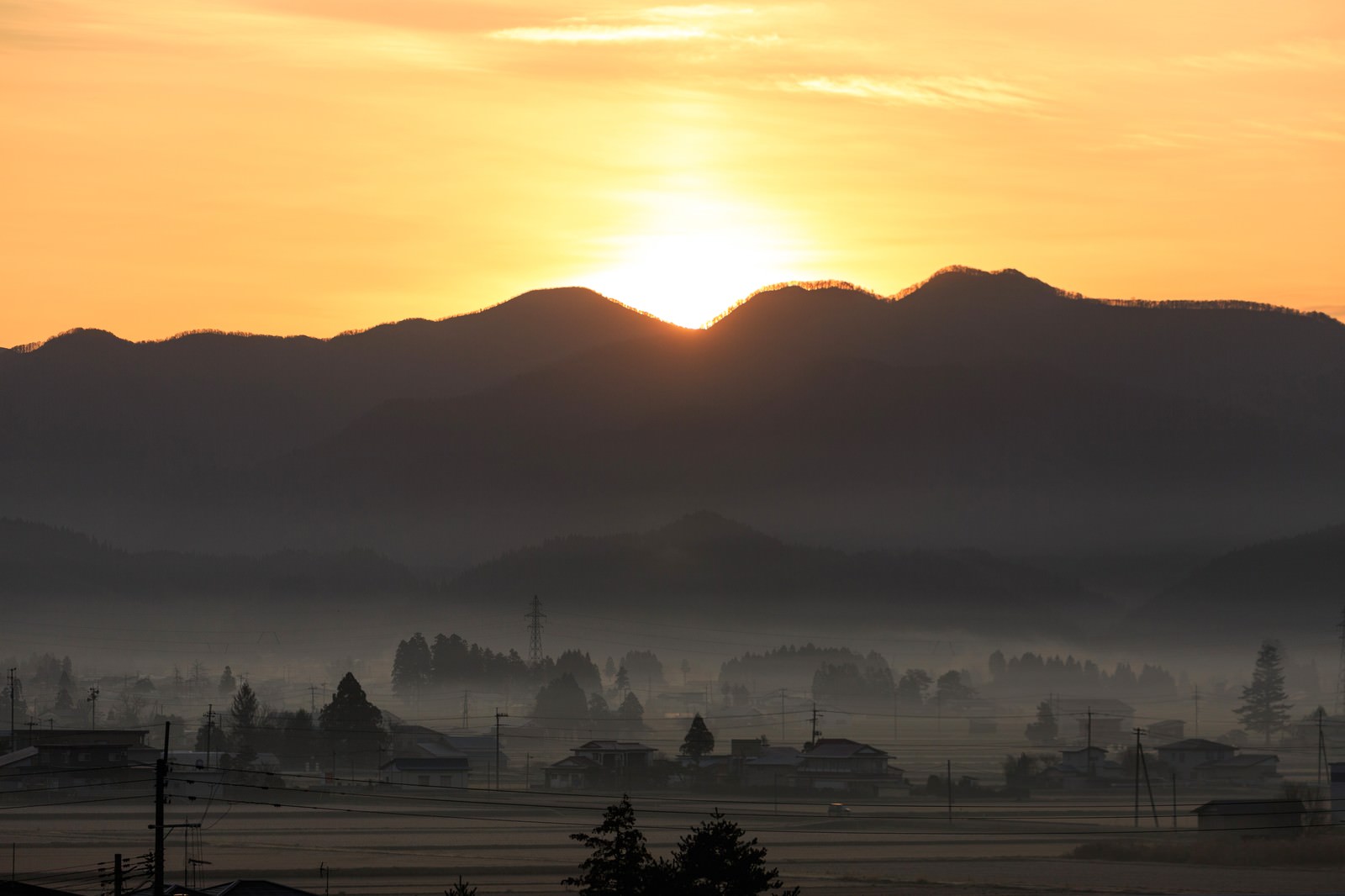
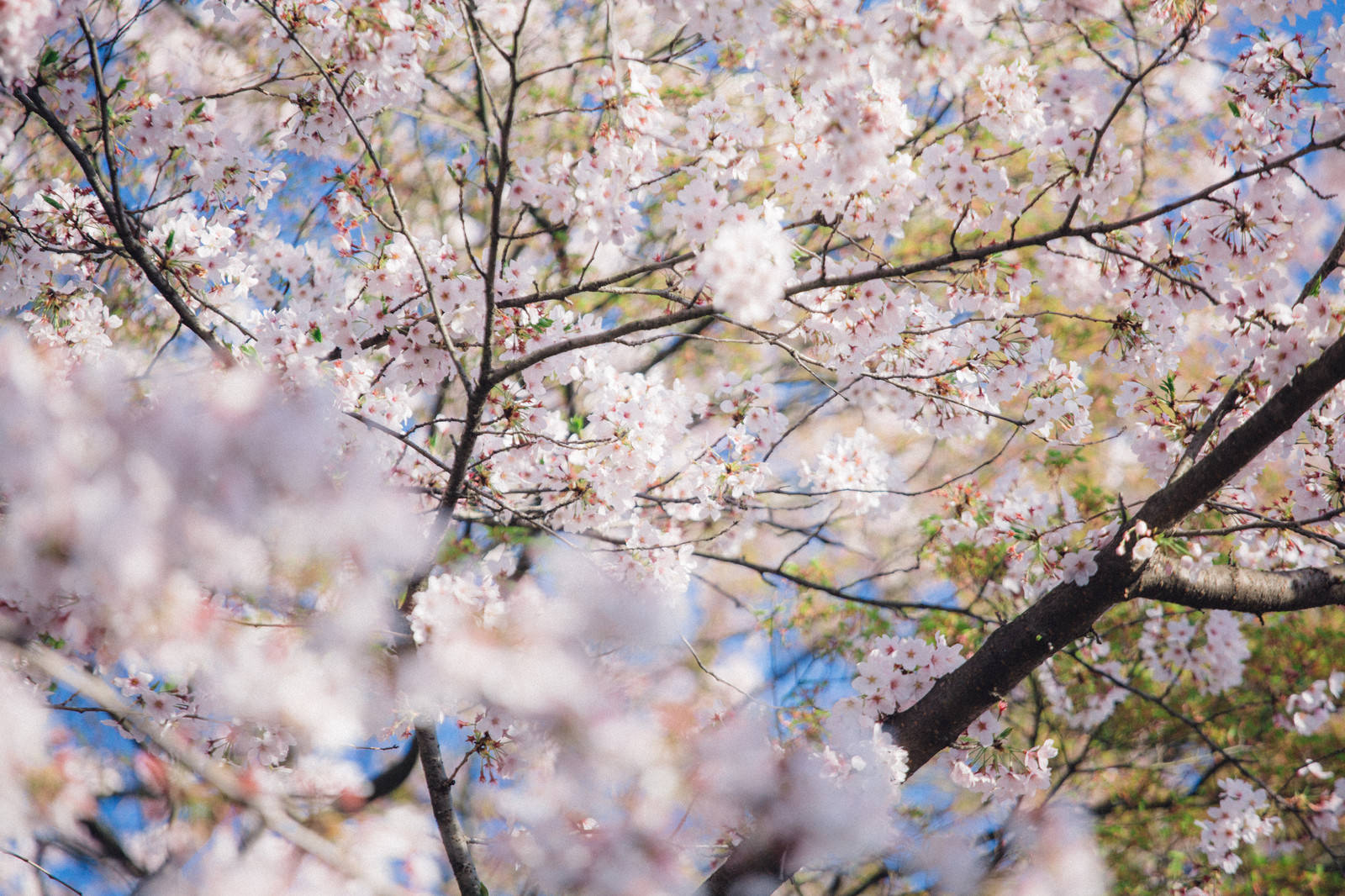
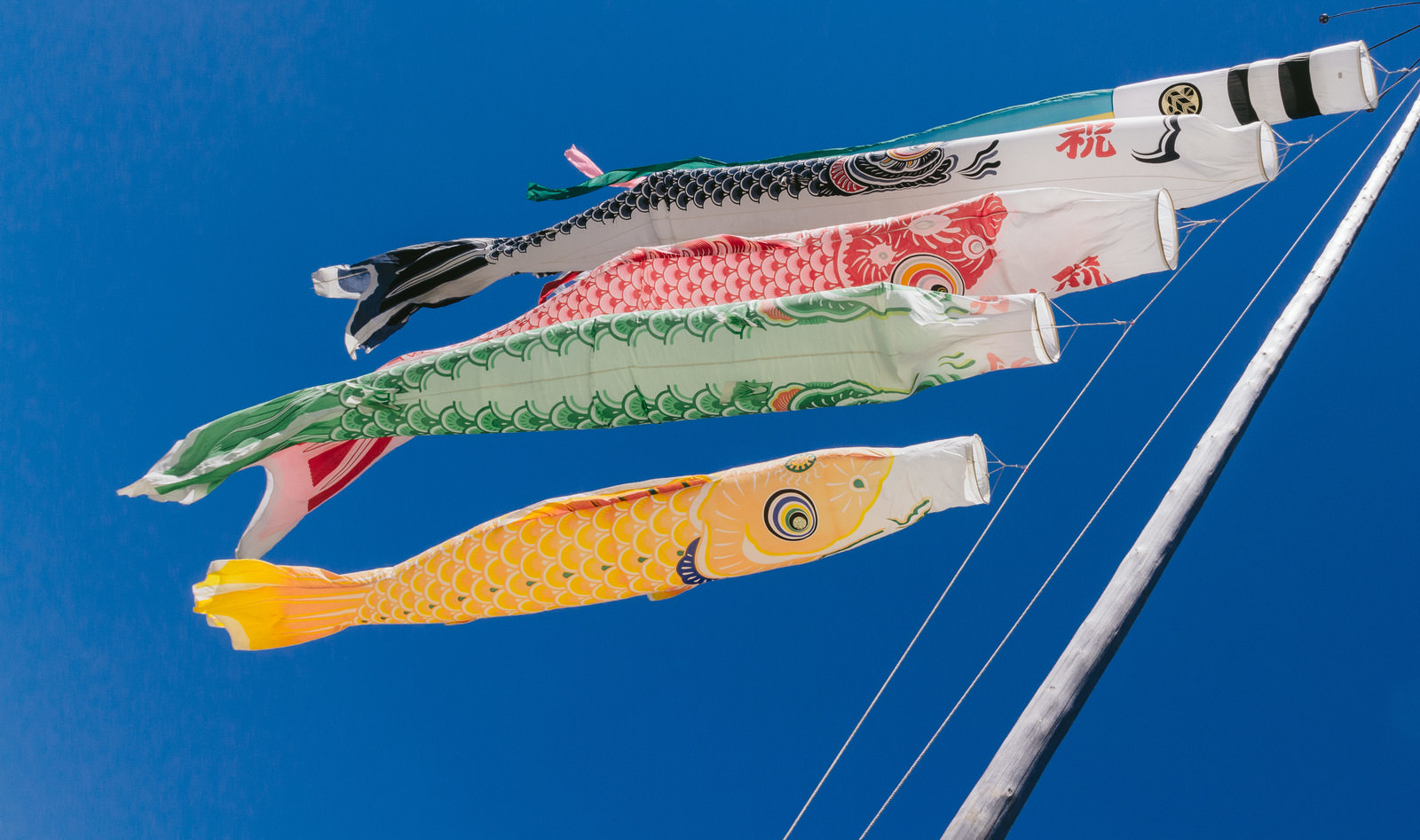


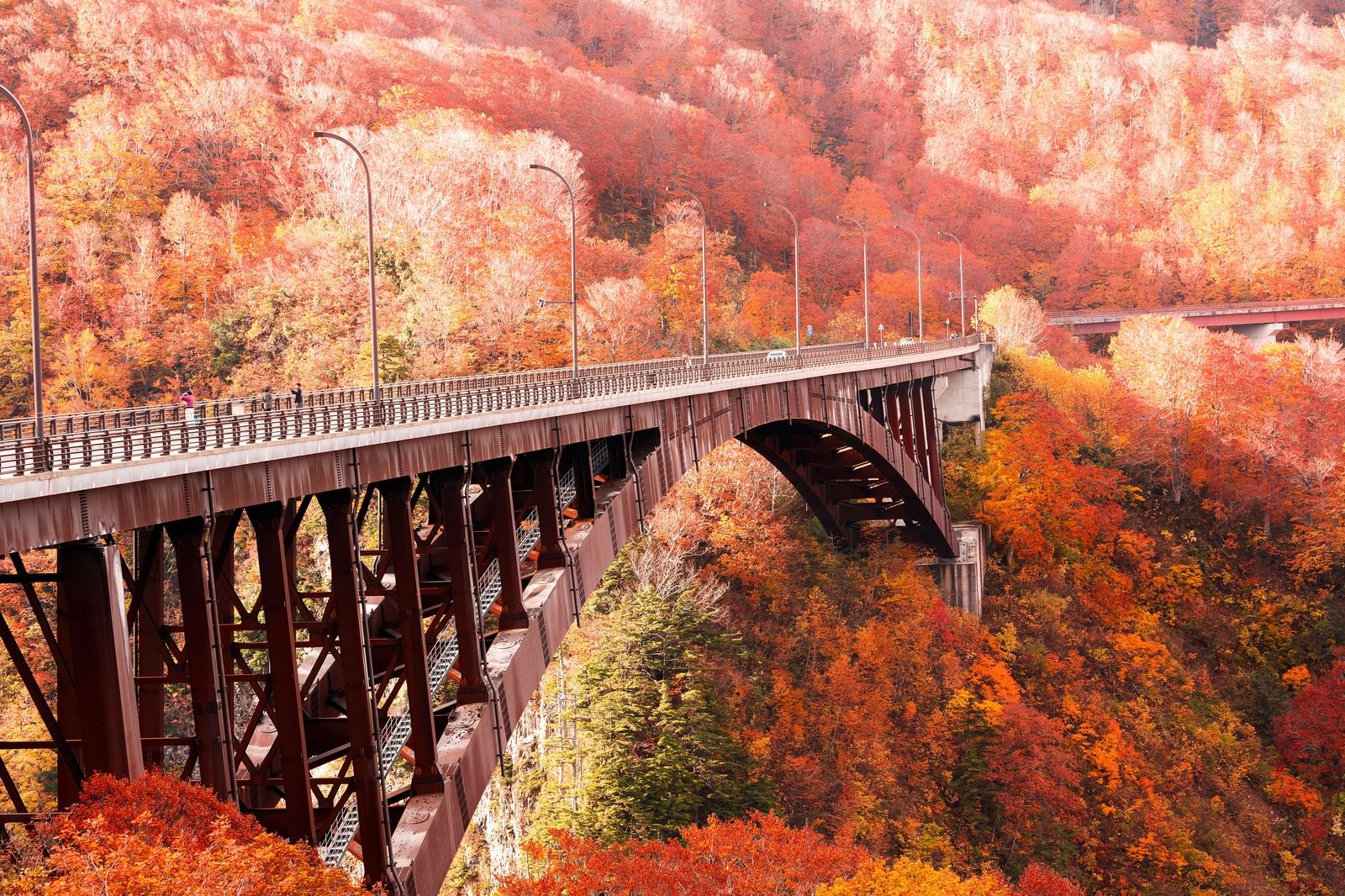










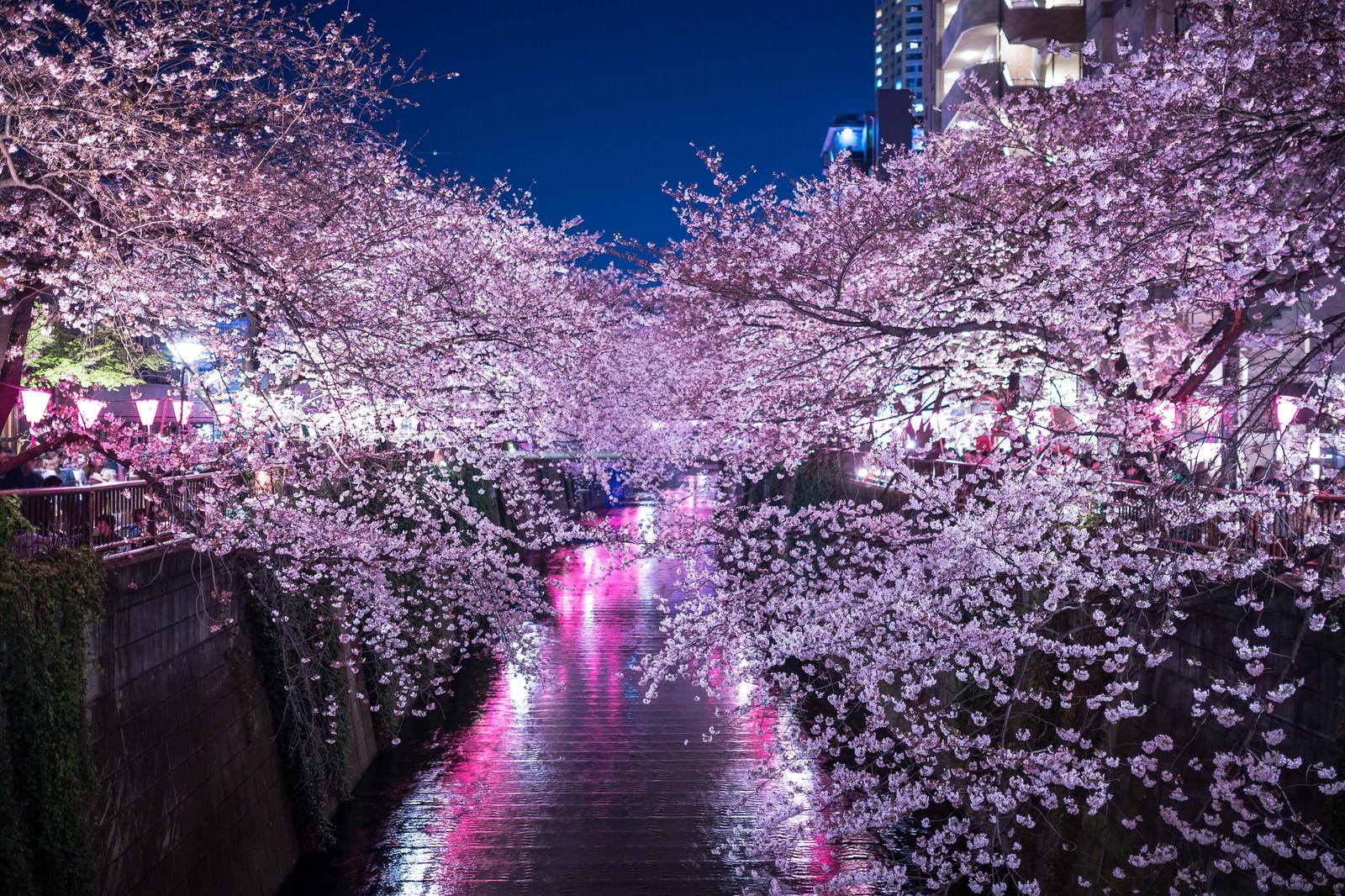

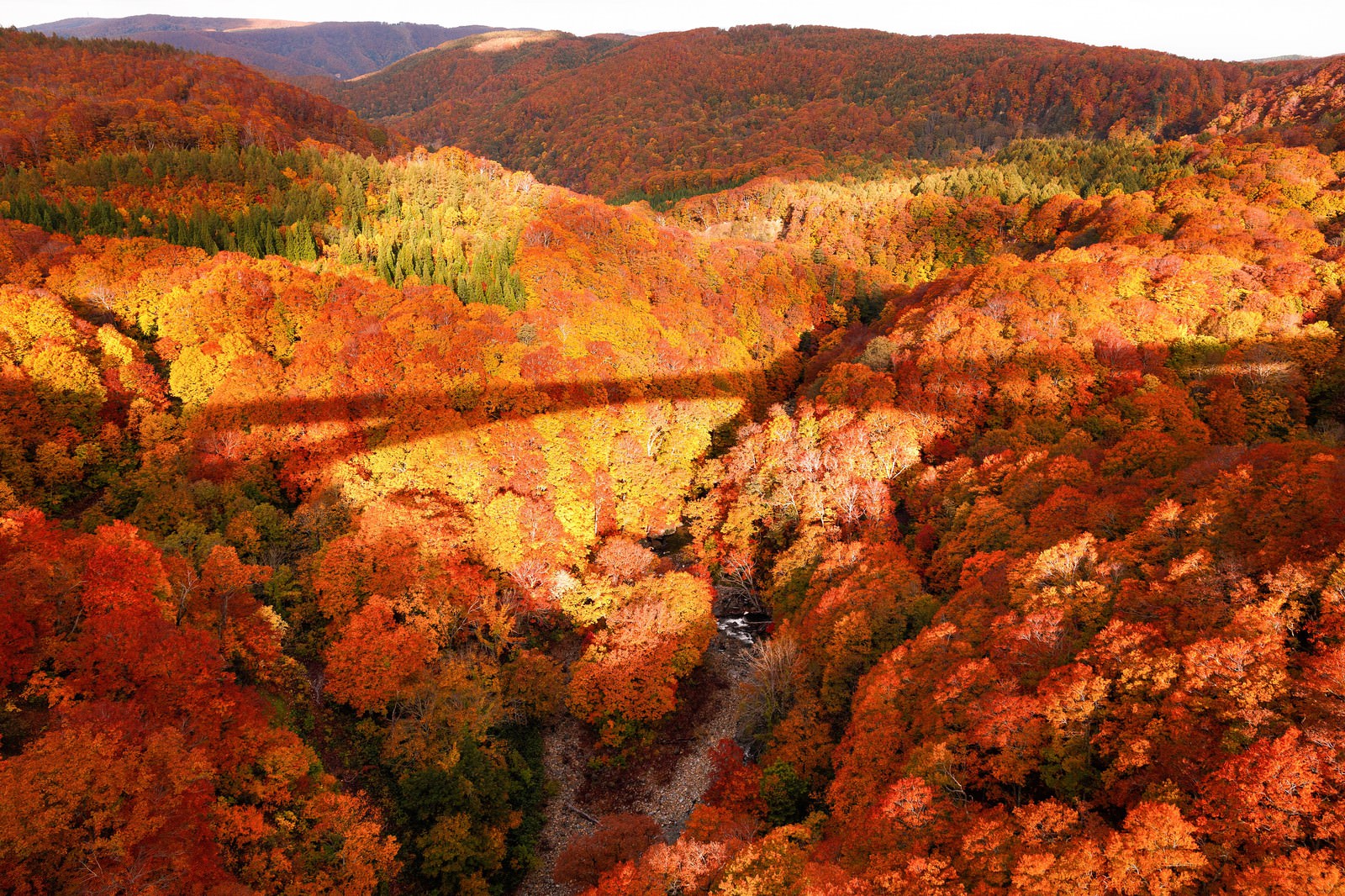
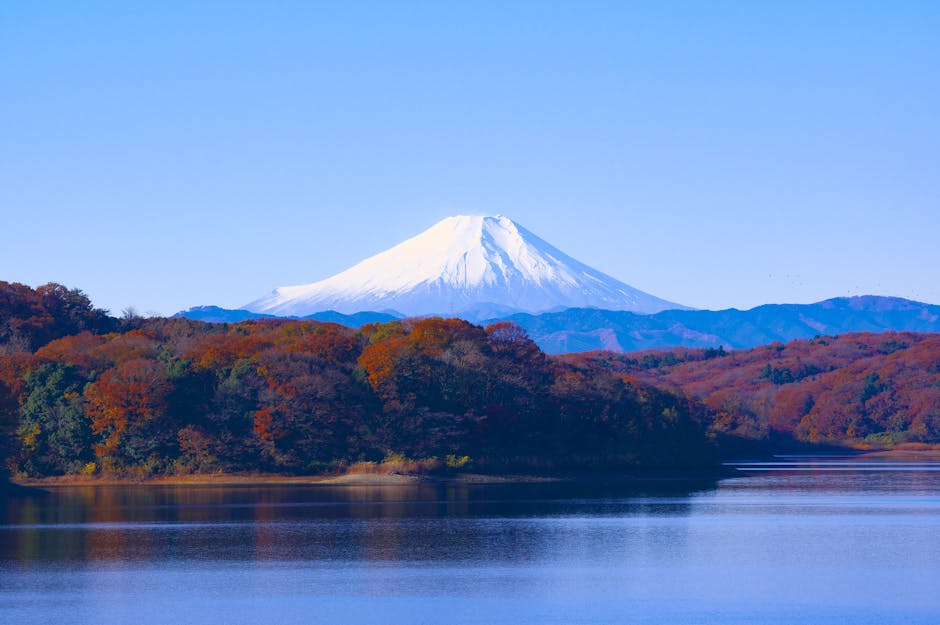
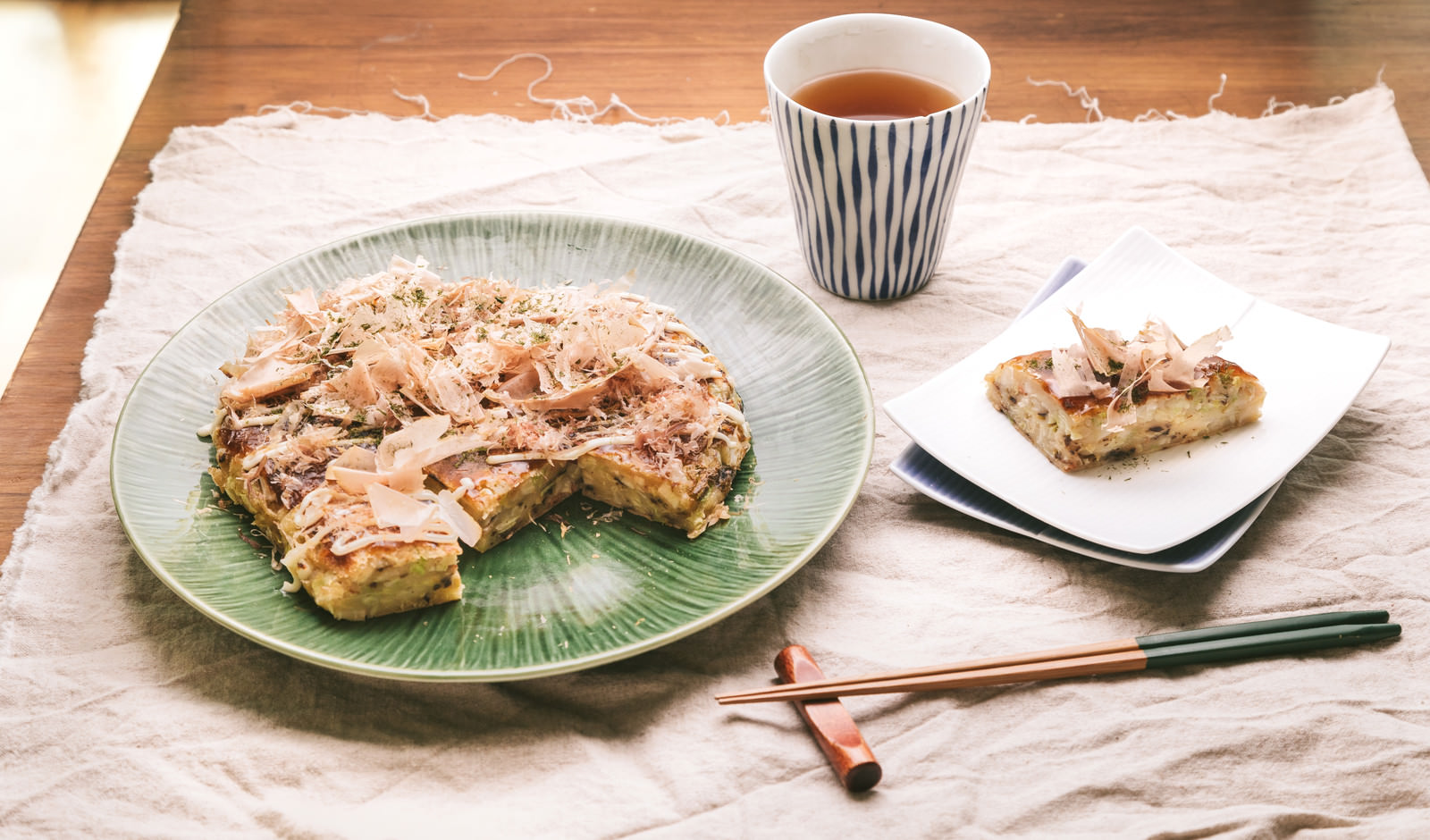
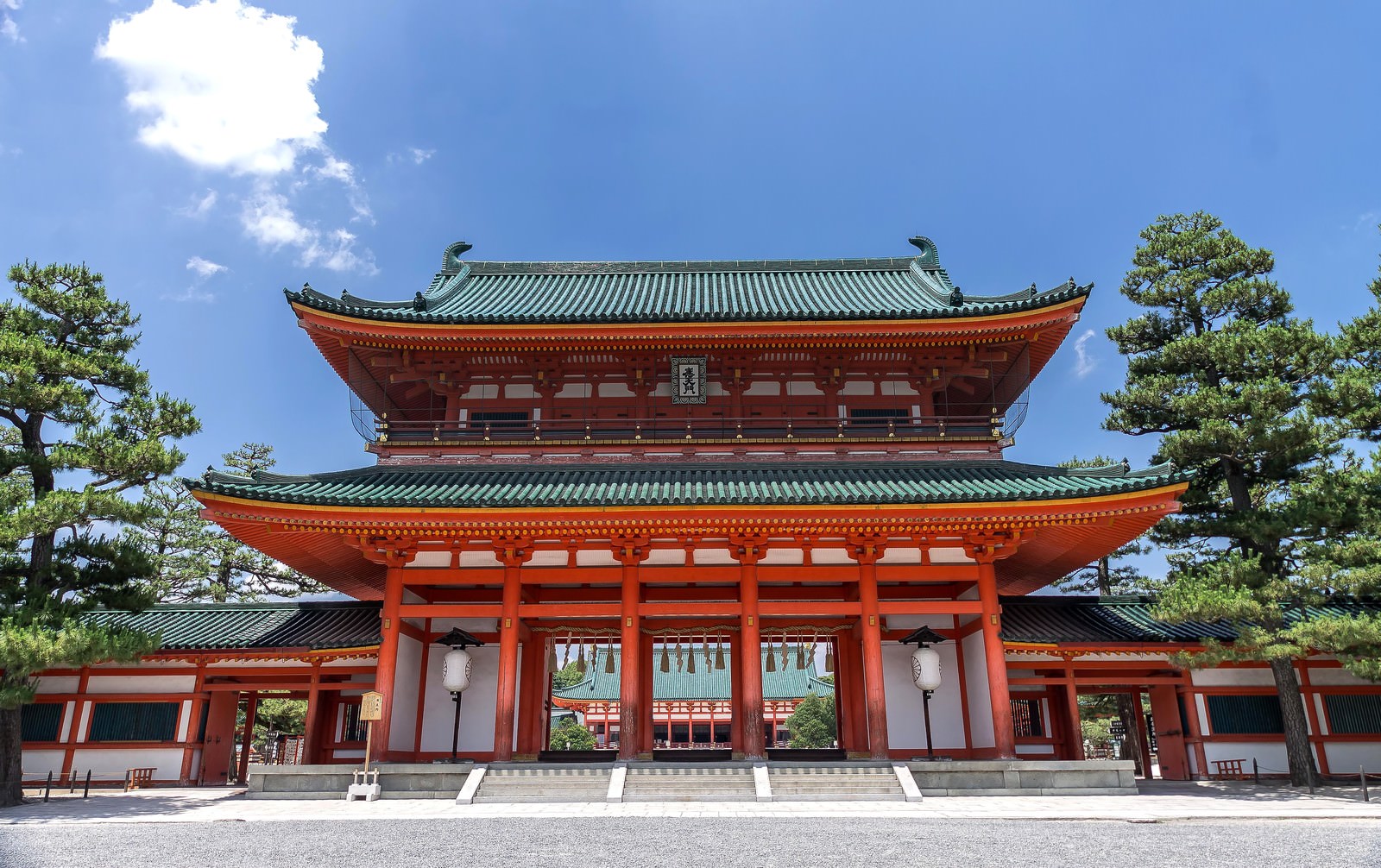
![「大好物のハンバーガーを与えてみた大好物のハンバーガーを与えてみた」[モデル:段田隼人]のフリー写真素材](https://www.pakutaso.com/shared/img/thumb/TRTM9463_TP_V.jpg)



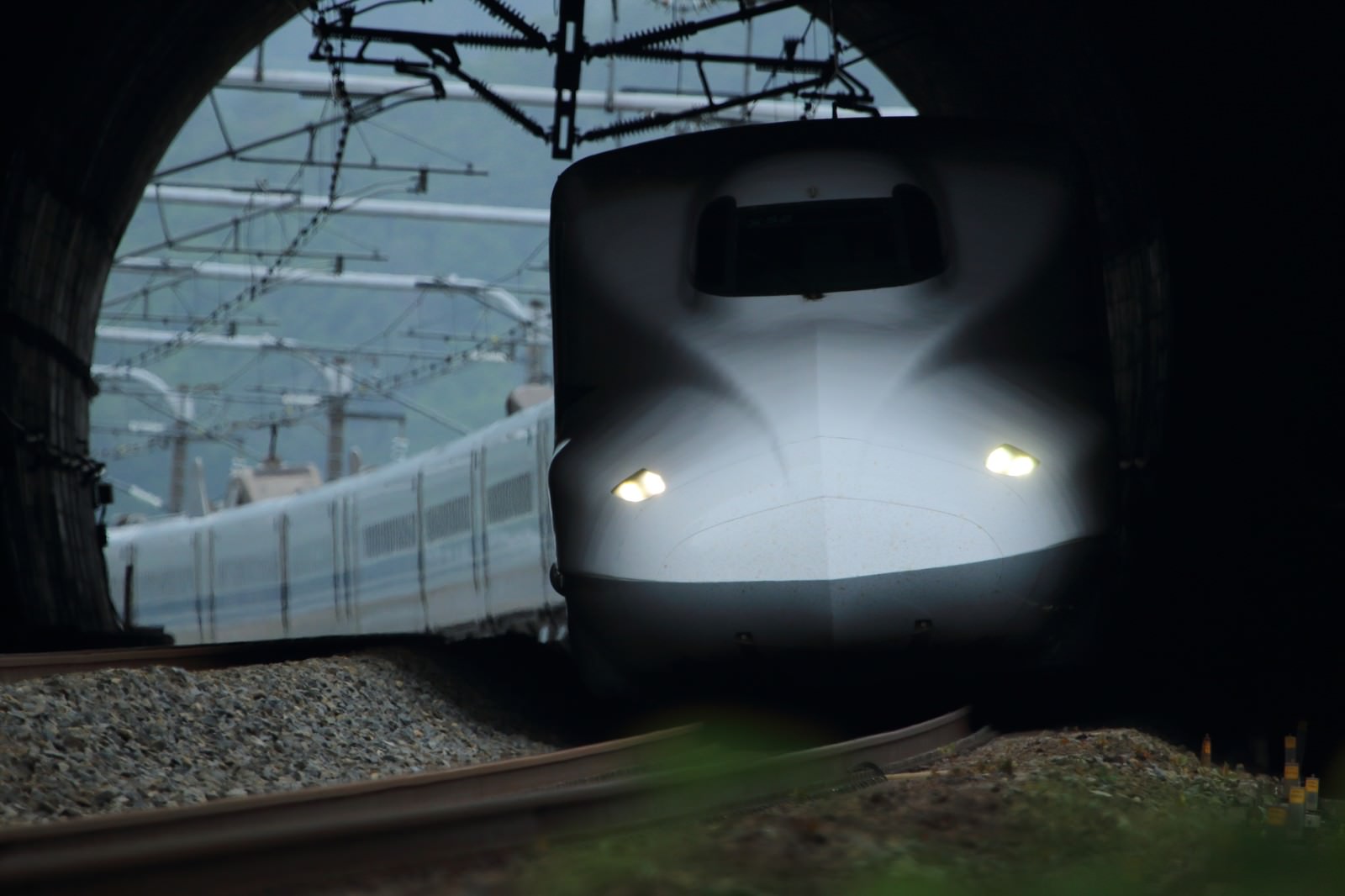
![「両手いっぱいの買い物袋を持ったセールが大好きな女性(グリーンバック)両手いっぱいの買い物袋を持ったセールが大好きな女性(グリーンバック)」[モデル:河村友歌]のフリー写真素材を拡大](https://www.pakutaso.com/shared/img/thumb/prezent2girl20160902411418_TP_V.jpg)
